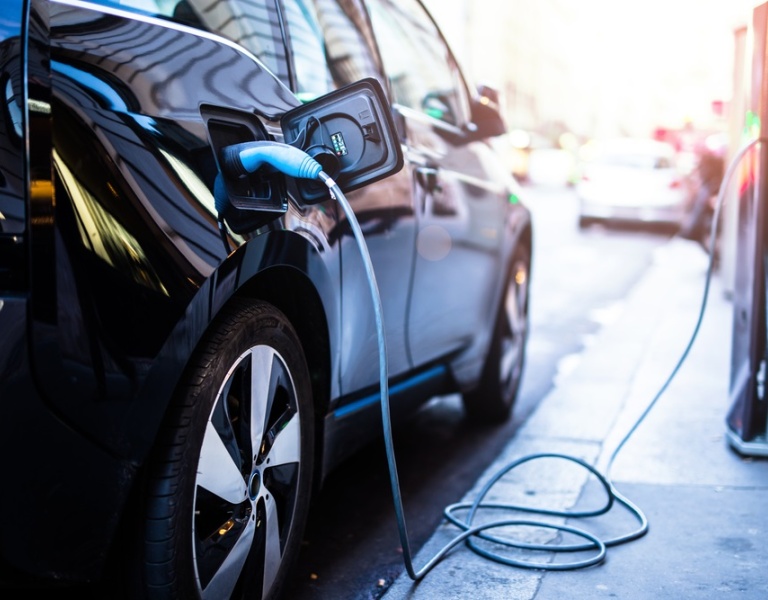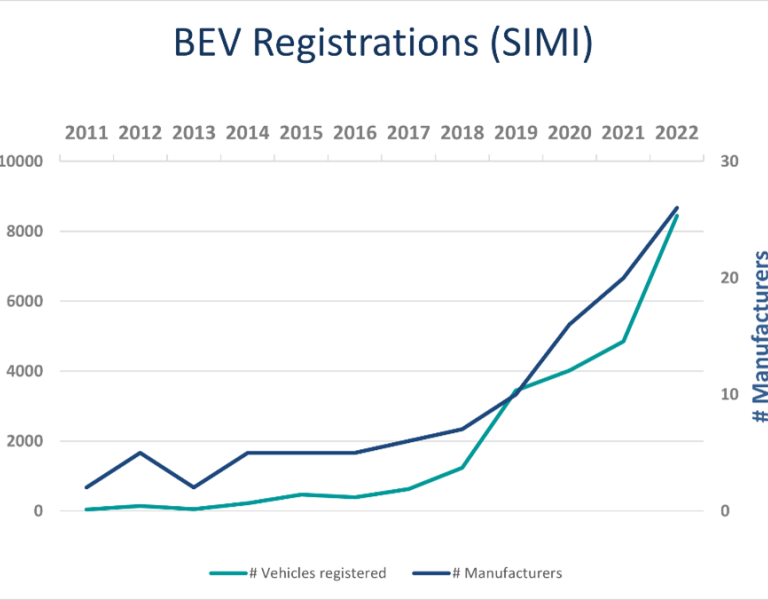Understanding EV Battery Life
Our latest EV Blog breaks-down the key details around EV battery life - what 'State of Health' means, the battery life differences between batteries for PHEVs (Plugin Hybrid Electric Vehicles) and BEVs (Battery Electric Vehicles), the link between range and capacity and more.

Batteries are the most expensive component and the component of most concern for drivers considering the switch to Battery Electric Vehicles (BEV) or Plugin Hybrid Electric Vehicles (PHEVs). What range will a battery provide? Will it degrade and need to be replaced? What is the potential impact on residual cost of the vehicle?
SIMI motorstats tell us that 46 BEVs were registered in Ireland in 2011, 45 of these were Nissan Leafs! By contrast for the first half of 2022, 8,444 BEVs were registered 54 different models - from 26 car manufacturers. 7 of the top ten selling models in 2022 were not on the market in 2019.
Confidence in long term battery health was a concern. State of Health (SoH) is the term used as a percentage measurement of the useful capacity of a battery. Can we predict long term EV battery health without real world data? To understand EV battery health we'll take a look at the technology that powers most EVs (hybrid vehicles that do not charge the battery from an external source aren't included).
Battery Types
All BEVs and PHEVs have two types of batteries for power storage, a 12V accessory battery and a traction battery pack.
- 12V accessory battery; a regular lead-acid battery is an EV's secondary power source which powers the vehicles electrical systems and accessories that run on a low voltage, like lights, central locking, battery management system and telematics. Systems that run on a low voltage have their own battery to simplify the battery management system. 12V battery is recharged by the alternator when the engine is running in an ICE vehicle and by the traction battery in an EV.
- Battery pack, or traction battery is the EV's rechargeable energy storage that provides instant, high voltage energy to the electric motor that drives the car. A battery pack is recharged by plugging into an external electricity supply, with some power potentially coming from regenerative braking.
An EV will not start without a charged 12V battery no matter how much charge is in a battery pack as it starts the onboard power system and energises the battery pack. The 12V battery in an EV is jump-started in the same way as those in an ICE vehicle. According to AA Rescue, it's more common for the 12V battery to go flat than to run out of charge in an EV.
In today's EV battery packs, Lithium-ion technology (Li-ion) is most commonly used. Sony released the first commercial rechargeable Li-ion battery in 1991, causing a revolution in mobile electronics and since then has evolved rapidly from powering laptops to powering cars!
Li-ion technology has a number of characteristics that make them suitable for EV's such as,
- high energy density (more power in a smaller package)
- high power to weight ratio because the size and weight will have a notable impact on the vehicle performance.
- they can be recharged and discharged daily from any state of charge (SoC) - a term to describe how full or empty they are (just like the fuel gauge).
The makeup of an EV battery pack
A Li-ion EV 'battery' is made up of a number of battery cells to make a 'module'. A number of modules connected in series and enclosed in a battery casing is known as a battery pack. A battery pack typically consists of thousands of cells, so if a single cell fails, it won't have a big impact on SoH, the battery will continue to do its job, unlike an ICE where a single failure stops the engine working altogether.
The type of battery pack depends on the make and model of EV and it's usually located along the floor of the vehicle.
Range vs Capacity
The total energy or capacity of an EV battery pack is measured in kWh (kilowatt-hours). The vehicles range is how far a vehicle can travel on a full charge, this is typically in proportion to the capacity of the battery. Every model has a different battery size and efficiency, and therefore a different range.
As is the case for ICE vehicles, with fuel tanks of different sizes and mpg, EVs vary widely on the distance they can travel on a fully charged battery. Other variables that have an impact on real world electric range of a BEV or PHEV include driver behaviour (specifically speed, as with ICE vehicles the faster you go the less the range), driving conditions, topography, passenger load, auxiliary use and climate. This is no different from the performance of an ICE vehicle, but that's a whole other blog!
Although the SoH of PHEVs batteries will also be impacted by the same variables as BEVs, the all-electric range for PHEVs is a more complex given both fuel types are often used simultaneously.
The car industry challenge is to have a cost-effective, efficient battery to meet the needs of EV drivers who want longer range and faster charging. So, while electro chemists work on increasing battery capacity, what do we know about the expected lifespan of a Li-ion battery pack? What is the story with battery degradation (declining SoH), and what can EV owners do to minimise it?
Electric car batteries are being built to have a long lifespan, with most manufacturers guaranteeing 8 years or 160,000km (SoH of batteries >70-80%). Tesla Model S or X offer battery failure warranty of 8 years, or up to 240,000km, whichever comes first. There are reports online of EVs passing the 1,000,000km mark on the same battery!
Some Consumer Reports in the US estimate the average EV battery pack's lifespan to be at around 320,000 Kms, which is nearly 19.5 years of use if driven at the Irish average per car 16,400 Km per year (CSO 2019), longer than the expected lifespan of most vehicles (which is 10-14 years)! Read on to see why Irish EV battery packs may fair even better due to the Irish climate!
Reliability
EV batteries are more robust than those used in other mobile technologies and with their battery management systems they are unlikely to catastrophically fail. It is inevitable that the SoH of any Li-ion battery will gradually decline with use (charging/discharging cycles) resulting in reduced charge capacity and therefore reduced range. Many dealers have a warranty of 8 years or160,000km on their batteries which shows the decline in the battery will take years to happen.
Power degradation, or loss of performance in delivering power to the powertrain is rarely observable in EVs, but the recharging performance or efficiency may degrade.
The cost of battery packs has decreased by 88% in the last 10 years according to Forbes. This decline in price was expected to continue in 2022 but has been impacted by conflict, inflation and market conditions.
Long term battery degradation is influenced by many variables such as temperature, charging patterns and use. Keeping these variables in mind when forming usage habits can extend the lifespan of the battery. Manufacturer recommendations for specific vehicles should be followed to optimise the battery lifespan.
Temperature
Temperature sensitivity is a weakness of Li-ion technology. High (desert like) temperatures decay Li-ion cell performance, and they produce heat during operation. Temperature can affect battery degradation in the long term and also fast recharge time in the short-term.
In general, warmer climates negatively affect the lifespan of an EV battery more than colder climates. High temperatures can negatively affect battery lifespan and range, but does not affect recharge time, and low temperatures can negatively affect recharge time and range but does not impact battery lifespan.
A battery management system monitors and maintains optimum temperature of the battery pack by active heating/cooling. Like the human body functions best at 37deg, an EV battery chemistry functions best in a moderate temperature range. Tests have shown that at -6 degrees C an EV loses 12% of its range on average compared to 23 degrees C. Day to day, temperature also impacts the range as the battery supplies power to heat/cool both the cabin (for driver comfort) and the battery (for optimum operating performance).
The cooling systems of EVs vary - if your EV has the functionality to precondition the battery temperature for optimum performance, refer to your owner manual on how to make best use of this feature.
Another significant variable is charging patterns. Constantly depleting to 0% and recharging to 100% can cause battery degradation, but experience has shown EV owners do not do this. Nevertheless, to prevent complete discharge or over charging, manufacturers build some contingency into the lower and upper end of the usable battery capacity that's not available for use.
The Li-ion cells in battery packs of most modern electric cars don't like to be kept at a full state of charge or a very low state of charge for long periods. To optimise the life of an EV battery, standard advice is to maintain a SoC between 20% and 80% day to day.
Although convenient, fast charging (DC charging) produces more heat than AC charging and this heat can cause decay in the battery. Ideally AC charging should provide the majority of charging needs, with minimum use of fast charging will prolong battery life.
Lifespan
Demonstrating the impact of charging pattern on battery lifespan, Hyundai published numbers on their website showing huge variability in lifespan of their Soul Booster EV (64kWh, max range 386kms).
If the battery is exhausted and recharged to 100%, the battery can be used for 1,000 charges. If it is used to 50% and recharged, the battery can be used for 5,000 charges. If it is 20% used and recharged, it can be used for 8,000 charges.
In summary, Hyundai claim if their Soul Booster EV is driven for 77 kms/day (equivalent to the 20% of the maximum driving distance) and recharged every night, the battery can last for 8,000 days (22 years).
In 2020 GeoTab, a telematics solution provider, published real world battery data of 6,000 EVs (BEV & PHEV) over millions of days to produce 2 free to use tools that provide invaluable insight into the impact of temperature and SoH of EV batteries in the long term.
This real-world data showed the average EV battery lost around 2.3% capacity per year. In other words, a 300km range EV today will have lost 34km in 5yrs. Data also showed that heat & fast-charging (DC charging) is responsible for more battery degradation than age or mileage7, so high levels of use i.e. driving or mileage does not appear to be a concern.
GeoTab's real world data along with other reports of EVs far surpassing their warranty by multiples of distance, cases of high level of use are plentiful. For example a 2017 Renault Zoe 52kWh, that's in use as a taxi in (hot) Turkey with 345,000Kms on the clock and a near perfect 96% SoH after driving further than an average Irish car's life expectancy.
Now that we have explained battery technology and how it degrades over 300,000+km, how do you think it compares to an ICE? What state would a diesel or petrol engine be in after 300,000km - would you buy it with confidence of maintenance- free motoring?
EVs keep going, - their range may reduce slightly over time, but they are more reliable than ICEs, where if a single component fails the engine and car stop altogether.
A final point is that it is early days yet for EV and batteries -, recycling centres are only being piloted now because there are so few EV batteries around to be recycled with the vast majority (from written off vehicles) going into second life as backup to the electricity grid.




